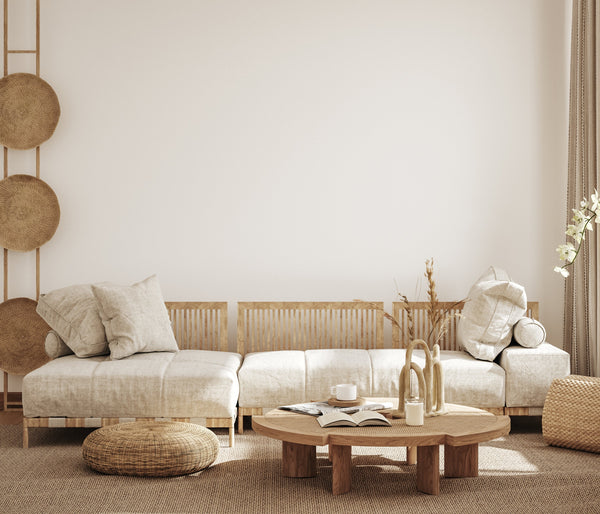
Jump to:
In recent years, an interior design trend has captured the imagination of homeowners and designers alike: Japandi.
“What is Japandi?” You might be asking.
Well, we’re basically talking about a fusion of Japanese and Scandinavian aesthetics. Do you like mid-century modern? If so, Japandi could be right up your alley.
Japandi offers an updated approach to a familiar (and widely appreciated) design concept: creating spaces that are both functional and visually appealing. This style captures the warm, textured elements of Scandinavian design while embracing the minimalist grace of Japanese interiors.
What Is Japandi Style? Why Is This Design Movement Popular?
Japandi is a hybrid design philosophy that brings together the clean lines & muted colors of Scandinavian interiors with the natural elements & minimalist approach of Japanese design.
The ensuing new design form translates to creates spaces that are calm, uncluttered and deeply connected to nature. Japandi interiors typically feature a neutral color palette, natural materials and a focus on simplicity and functionality.
The essence of Japandi lies in its ability to create harmony between two seemingly different design traditions. Japandi emphasizes the importance of creating a peaceful, welcoming environment that promotes relaxation and mindfulness. This style appeals to those who appreciate minimalism but desire a touch of warmth and coziness in their living spaces.
What Are the Elements of Japandi Design?
Japandi style incorporates several key elements that define its unique aesthetic:
- Neutral Color Palette: Japandi interiors often feature muted, earthy tones such as beige, gray and soft whites. These colors create a calm backdrop that allows natural materials and textures to shine.
- Natural Materials: Wood, stone, bamboo and other organic materials play a crucial role in Japandi design. These elements bring warmth and texture to spaces, connecting the interior with the natural world.
- Minimalist Approach: Japandi embraces the concept of "less is more." Spaces are uncluttered, with carefully chosen furniture and decor pieces that serve both functional and aesthetic purposes.
- Functional Design: Every item in a Japandi interior has a purpose. Furniture is often multifunctional, and storage solutions are integrated seamlessly into the design.
- Craftsmanship: Both Japanese and Scandinavian design traditions value high-quality craftsmanship. Japandi interiors often feature handmade items and artisanal touches that add character and depth to spaces.
- Contrast: While Japandi favors a neutral palette, it also incorporates subtle contrasts. This might be achieved through the use of different textures or by introducing darker wood tones against lighter backgrounds.
Are Japandi and Wabi-Sabi the Same Thing?
While Japandi and wabi-sabi share some similarities, they are distinctly separate concepts.
Wabi-sabi is a Japanese philosophy that finds beauty in imperfection and transience. It embraces the idea that objects and spaces become more beautiful as they age and show signs of wear.
Similarly, kintsugi is a Japanese art style that embraces the imperfect; we see kintsugi in various types of Japanese ceramic pottery, for example.
Now, it’s not to say that there’s no overlap between these concepts and Japandi; you might find a piece of Japanese pottery with kintsugi elements in a Japandi living room. But they’re not the same thing.
Japandi is a design style that combines elements of Japanese and Scandinavian aesthetics, though not necessarily embracing imperfection. While it may incorporate some aspects of wabi-sabi, such as an appreciation for natural materials & simplicity, Japandi is not inherently focused on imperfection or the passage of time.
The main difference lies in their approach to aesthetics.
Wabi-sabi celebrates the beauty of imperfection and the patina of age, while Japandi seeks to create harmonious, well-crafted spaces that balance minimalism with warmth. However, both philosophies share a deep appreciation for nature and simplicity, which is why they can complement each other in interior design.
History & Origins of Japandi Style
The origins of Japandi can be traced back to the cultural exchange between Japan and the Nordic countries that began in the late 19th century.
Danish designers, in particular, were inspired by Japanese aesthetics and began incorporating elements of Japanese design into their work.
This cross-pollination of ideas continued throughout the 20th century, with both Japanese and Scandinavian design gaining global recognition for their emphasis on simplicity, functionality and connection to nature. The term "Japandi" itself is relatively new, coined in the early 2010s as interior designers began to consciously blend these two design traditions. It’s really come full circle, hasn’t it?!
The rise of Japandi coincides with a growing interest in minimalism and sustainable living. As people seek to create calm, uncluttered spaces that promote well-being, the Japandi aesthetic offers a compelling solution that balances aesthetics with functionality.
Elements and Characteristics of Japanese and Scandinavian Styles
Japandi style draws from both Japanese interior design and Scandinavian-style design, creating a unique aesthetic that combines the best of both worlds.
Let’s take a closer look at how these two design traditions come together in Japandi.
Japanese Style Interior Design Elements
- Zen-inspired minimalism
- Natural materials like wood, bamboo and paper
- Low-profile furniture
- Sliding doors and screens (shoji)
- Tatami mats
- Asymmetrical balance in design
Scandinavian Style Design Elements
- Light, airy spaces
- Neutral color palettes with pops of muted color
- Cozy textiles like wool and sheepskin
- Functional, streamlined furniture
- Emphasis on natural light
- Hygge concept (creating a warm, inviting atmosphere)
In Japandi, these elements are blended to create spaces that are both minimalist and cozy, functional and aesthetic. The result is interiors that feel calm and uncluttered, yet warm and inviting.
Examples of Japandi Style
Japandi style can be applied to various rooms in the home, each with its own unique interpretation of the aesthetic. Here are some examples of how Japandi can be incorporated into different spaces.
Japandi Kitchen
A Japandi kitchen typically features clean lines and uncluttered countertops. Natural wood cabinetry is often paired with stone or concrete countertops. Open shelving displays a carefully curated selection of ceramics and cooking utensils.
The color palette is neutral, with muted tones like soft grays and warm beiges. Lighting fixtures are simple and functional, often featuring natural materials like bamboo or paper.
Japandi Dining Room
In a Japandi dining room, you might find a low-profile wooden table surrounded by simple chairs with clean lines.
The dining set could be complemented by a statement pendant light made of natural materials. Wall decor is minimal, perhaps featuring a single piece of art or a carefully placed plant.
The overall effect is one of calm simplicity that encourages mindful dining experiences.
Japandi Living Room
A Japandi living room balances comfort with minimalism.
A low-slung sofa in a neutral tone might be paired with accent chairs featuring natural materials like rattan or woven rush seats.
Textiles in muted colors add warmth and texture. Plants play a significant role in Japandi, allowing you to have nature indoors. Storage solutions are sleek and integrated, maintaining the uncluttered aesthetic.
Japandi Bedroom
In a Japandi bedroom, the bed is often the focal point, featuring simple, high-quality linens in neutral tones.
A low wooden platform bed frame is a common choice. Nightstands are minimal, perhaps just a floating shelf on each side of the bed. Lighting is soft and warm, creating a cozy atmosphere. Window treatments are simple, allowing natural light to flow in while maintaining privacy.
10 Tips on How to Bring Japandi Style Into Your Home
Incorporating Japandi style into your home doesn't require a total overhaul. Looking for some tips to help you introduce the Japandi aesthetic at home? Here you go!
- Declutter: Start by removing unnecessary items from your space. Japandi style thrives on minimalism, so focus on keeping only what you truly need and love.
- Embrace Natural Materials: Incorporate wood, stone and natural fibers into your decor. This could be through furniture pieces, flooring or smaller decor items.
- Choose a Neutral Color Palette: Opt for muted, earthy tones as your base colors. You can add depth with darker accents or subtle pops of color.
- Invest in Quality Pieces: Both Japanese and Scandinavian design value craftsmanship. Choose well-made furniture and decor items that will stand the test of time.
- Bring Nature Indoors: Add plants to your space. Bonsai trees, bamboo or simple potted plants can help create a connection to nature.
- Focus on Lighting: Use a combination of natural light and warm, soft artificial lighting to create a cozy atmosphere.
- Incorporate Textures: Add warmth to your space with textured textiles like wool throws, linen curtains or woven rugs.
- Keep it Simple: Remember that in Japandi style, less is more. Choose decor items carefully and give each piece room to breathe.
- Balance Form and Function: Select furniture and decor that are both beautiful and practical. Multi-functional pieces are particularly valuable in Japandi interiors.
- Add Personal Touches: While maintaining a minimalist aesthetic, don't be afraid to incorporate items that have personal meaning. A carefully chosen piece of art or a family heirloom can add character to your Japandi-inspired space.
Japandi: The Art of Creating Balance and Tranquility at Home
Japandi style offers a thoughtful blend of Japanese and Scandinavian design traditions, providing a harmonious approach to interior design. This fusion creates visually appealing spaces that promote a sense of calm, balance, and well-being.
With its emphasis on simplicity, natural materials, and functional elegance, Japandi resonates with those seeking minimalism in their living spaces. It offers a perfect balance of style and functionality, creating spaces that feel both cozy and zen.











0 comments